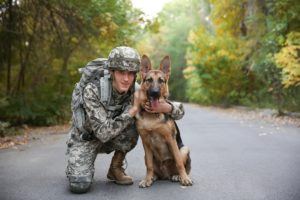A HISTORY OF MILITARY WORKING DOGS (MWDS)
The earliest recorded use of canines in combat was around 600 BC by the Egyptians, Greeks and Romans. However, no military in history has used them as extensively, or as effectively as the United States. Military service dogs have served in combat alongside our soldiers from every major conflict since the birth of this nation, but they were not officially recognized until World War II. Prior to WWII, dogs were mostly used as message carriers and sentries, but nowadays, they’re trained to perform a wide range of highly specialized tasks such as sniffing out bombs and drugs, tracking people, and even attacking when necessary. There are about 2,500 military war dogs in service today, with about 700 serving overseas.
Military working dogs (MWDs) undergo a very thorough assessment before being chosen and only 50% of those make it through training. Not only are military dogs expected to have an extremely keen sense of smell, but they must be free of physical issues, motivated by a reward system in addition to being able to attack on command. Many puppies have been disqualified due to exhibiting anxiety at having to bite a human.
A common fallacy is that all MWDs are German Shepherds, however, there are several different breeds that are utilized for military service. A few of the more common ones are as follows:
- German Shepherd
- Doberman Pinchers
- Labrador Retrievers
- Dutch Shepherds
- Belgian Malinois
For years, 85% of military working dogs were purchased from Germany and the Netherlands because their dogs have been purposely bred for military service for hundreds of years. This allowed the U.S. to select dogs that had the most ideal traits of aggressiveness vs. playfulness vs. tenacity vs intelligence. More recently the U.S. has collaborated with the American Kennel Association to encourage a breeding program to develop our own pool of military services dogs. The largest military service dog breeding program in the world is located at Lackland Air Force Base in San Antonio, TX and provides dogs to every branch of service.

The cost associated with training a military service dog runs approximately $150,000 to the DOD, however, these dogs possess a 98% accuracy in detecting bombs and drugs. Some would say their effectiveness far outweighs their cost to train. Upon completion of their training, these dogs are considered noncommissioned officers. Traditionally their rank has been one step higher than their handler to ensure there was no mistreatment of the dog while in service.
The average career span for a military working dog is approximately 9-11 years. Prior to 2000, military working dogs were considered “surplus equipment” and were euthanized or abandoned after their retirement. It is estimated that approximately 4000 MWDs were left in Vietnam at the end of the war with only a little over 200 dogs making it home. After 2000, President Clinton passed “Robby’s Law” allowing handlers and their families to get first dibs at adopting their MWD. Today, over 90% of retired MWD’s are adopted by their former handlers. In addition, many dogs continue to support local law enforcement after retirement. If a handler is unable to adopt their working dog, the DOD identified other willing families to ensure the dog has a home. From 2012-14, 1,312 dogs were adopted by individual families and 252 were adopted by law enforcement agencies.
Some of this countries most famous Military Working Dogs are listed below:
Sergeant Stubby – WWI
In WWI, a Pitbull stray named Stubby, became the most decorated War Dog in history. John Robert Conroy, a recruit in training for WWI found Stubby on a field at Yale University. Conroy didn’t want to leave Stubby behind so he smuggled him under his overcoat onto his ship deploying to France. He quicklybecame the “unofficial official mascot” of the 102nd Infantry, 26th (Yankee) Division. While deployed with Conroy, he successfully warned soldiers of mustard gas attacks, incoming artillery shells, as well as delivering supplies to wounded soldiers and capturing a German soldier. He was the first – and only – military dog to be promoted to sergeant.

Chips – WWII
The most decorated war dog of World War II was a German Shepherd/Colley/Huskey mix named Chips who served in Germany, France, North Africa, and Sicily, with the Army’s 3rd Infantry Division. Trained as a sentry dog, Chips broke away from his handlers and attacked an enemy machine gun nest in Italy and forced ten enemy soldiers to surrender.
Chips was wounded in the fight and was later awarded the Distinguished Service Cross, Silver Star and the Purple Heart, all of which were later revoked due to an Army policy preventing official commendation of animals.
Nemo – Vietnam War
During the Vietnam War, a German Shepherd, named Nemo served with his handler, Airman Robert Throneburg (USAF). While on maneuvers one day, Nemo sensed Viet Cong guerillas approaching and alerted Throneburg. Because of Nemo, Throneburg was not taken by surprise and both were able to put up a fight. Unfortunately, they were both wounded by the Viet Cong, yet a result of Nemo actions, they were able to keep the enemy at bay long enough for Throneburg to radio for help. Throneburg was found unconscious with Nemo standing guard over him. It was said that Nemo was so protective that he wouldn’t let anyone near Throneburg. With the help of a veterinarian, they were able to calm Nemo down in order to treat Throneburg. Throneburg was awarded the Purple Heart and Bronze Star with Valor for his actions. Nemo retired and was one of the first dogs allowed to return to the United States after serving in Vietnam.

Cairo – Operation Neptune Spear
Cairo was a Belgian Malinois and a canine member of the U.S. Navy SEALs. Cairo was part of the SEAL team that stormed Osama Bin Laden’s compound, May 2011, in Pakistan. Cairo helped secure the outside perimeter of the building and was tasked with tracking down anyone who tried to escape, as well as being on alert for any incoming interference.
Lucca – Iraq
Lucca, a German Shepherd/Belgian Malinois mix, served for six years in the United States Marine Corps, completing two tours of service. During her tours, she completed around 400 missions and saved countless lives by detecting explosive devices.
In 2012, Lucca was on her second tour in Afghanistan when she saved the lives of several Marines – but at a price. After finding one buried explosive, Lucca began the search for a second device in the area. The second device detonated injuring Lucca. Her handler at the time, Cpl. Juan Rodriguez, immediately applied a tourniquet to her front leg, but Lucca’s leg had to be amputated. Even with this devastating injury, Lucca was resilient and determined. According to Rodriguez, she immediately wanted to get up and start walking post-surgery. As a result of heroic actions, she was granted the Dickin Medal by the PDSA and was (unofficially) granted a Purple Heart by a fellow Marine who had also received the medal.
Military Working Dogs are an integral part of our security forces and continue to be a vital part of our presence in a multiple of scenarios. While we love our nation’s veterans and thank them for their service. It’s important to note that not all of our veterans have two legs. We also thank those heroes and know that their service doesn’t go without notice.
If you’d link to learn more about some of these heroes, don’t forget to shop at the store to see our selection of books. Come down to visit the Hawai’i Army Museum – it’s free! We are located at 2131 Kalia Rd, Honolulu, HI 96815 serving both Honolulu and Waikiki. We hope to see you soon. Aloha!
